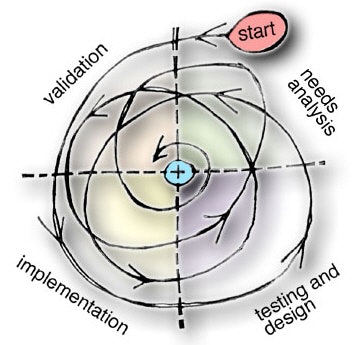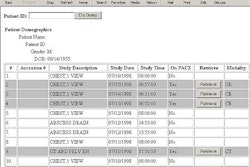
For a radiology department on a tight budget -- but with a desire to establish a collaborative environment in which to share images, databases, and reports -- a new piece of open-source technology may offer a cost-effective solution.
In a poster presentation at the 2003 Swiss Society for Radiology meeting in Lucerne, a group of researchers showcased their work on BolinOS IntRad, a multimedia authoring platform and Web operating system for Internet radiology.
The project, undertaken in the radiology department at Geneva University Hospitals in Geneva, Switzerland, utilized an Apache Web server, pre-hypertext processor (PHP), and MySQL database open-source code as its application base.
"The resulting Web operating system and its applications offers ‘non-power users’ the means to publish multimedia online and on CD-ROM, while enabling simple handling of users, user groups, agendas, forums, and collections with no previous extensive Web knowledge," the authors wrote.
The team started its project in January 2001 with the intent to build an internal and external Web site for the radiology department. As they delved into the project, however, they decided to also give users the capability to publish content as a means of departmental and intra-departmental collaboration.
User-led development
The developers met with ten representative employees of the department and established a consensus on appearance and navigation concepts so the application would have a homogenous appearance in all future iterations. Because all members of the department had to be able to participate in the creation and publication of online material, the tool would have to be simple to use and require no more than entry-level computer knowledge, the team decided.
 |
| The use of a spiral development model, instead of a more traditional cascading one, often created the impression of a constantly changing tool. However, the final gains in ergonomics and functionality have been numerous. Image and caption courtesy of Dr. Tristan Zand and the department of radiology, Geneva University Hospitals. |
The development team looked at the diversity of content the department might want to publish, such as reports, images, databases, teaching files, multimedia applications, and secured transactions and established that these should be able to be read on any Web-enabled computer platform, including handheld units. A further development caveat was that the future Web site was not only going to be used by the department’s more than 200 employees, but also by the rest of the hospital staff, as well as by some users worldwide.
"In order to preserve the possibility of a user-adaptable intranet, a modular framework was chosen to manage the IntRad portal," they explained.
The price is right
The developers decided on the PHP-coded BolinOS platform and its Linux software foundation because it has a free license, runs on most computer operating systems, has no proprietary code, and has one of the largest user and developer communities worldwide. In addition, according to the authors, it offers a versatile and recursive object and plug-in architecture with many pre-existing modules.
 |
| Each time a URL is called, a context is created according to user rights and profiles. The page follows a sequential construction that enables object recursivity to create a subcontext, such that shown by the page-in-page plug-in, which allows complex constructions. Image and caption courtesy of Dr. Tristan Zand and the department of radiology, Geneva University Hospitals. |
The team took into consideration the relative immaturity of Web-based technology as part of its design philosophy in order to ensure exportation to newer-generation applications, such as a new RIS or operating system upgrade. With their design philosophy and toolkit established, the group started development in February 2001. They had launched their intranet and Internet application by June 2001.
"The environment has multilayer security as well as ‘what you see is what you get’ management of all content," they wrote. "The recursive object-oriented framework enables real-time tracking (and) remote support, as well as on-the-fly content modification or application tuning."
Before June 2003, coding and upkeep on IntRad varied between one person working an average of 20 hours per week, to as many as three workers clocking 84 aggregate hours per week on the project.
System evolution
Publishing data to IntRad involves the use of modules or plug-ins, dubbed Bolino by the developers. There are currently more than 60 of these application building blocks available that allow the publication of text, HTML, and binary files such as images, videos, and formatted documents on the system.
 |
| The IntRad Web platform offers access from any in-house Web browser, such as on this unit located in a CT scanner room. Image and caption courtesy of Dr. Tristan Zand and the department of radiology, Geneva University Hospitals. |
"Using basic document management plug-ins, users have been able to publish agendas, charts, plans, lists and many casual-use documents," wrote the authors.
The developers said that the department’s radiologic technologists were the first group that utilized the publishing potential of the system, and have been responsible for much of the fine-tuning of the interface ergonomics. Physicians have used agenda plug-ins on the system to publish integrated to-do lists that give other physicians access to those portions of the list that pertain to them.
The group has also used IntRad to create and disseminate standard templates used for dictating radiological interpretations, as well as practice guidelines. A synchronized hospital handheld directory that is generated by a BolinOS plug-in has been created for Palm system users. This plug-in permits the critical care department of the hospital and the radiologists to author and share new files on their handheld computers, the developers said.
The IntRad system has enjoyed widespread acceptance by the user community at the hospitals since its introduction 2½ years ago. The system is currently managing 3.5 GB of data with approximately 1.6 GB, or roughly 4,000 pages, consulted by staff each week. In addition, since making the installer download freely available on its Web site, there have been more than 15,000 downloads to more than 100 countries.
The IntRad system has also found uses other than radiology and medical informatics at Geneva University Hospitals, particularly for the development team.
"There is even a Webcam integrated into IntRad so that those of us who work in windowless areas (the division is located in the basement) know whether or not to grab an umbrella before going outside," the authors said.
By Jonathan S. BatchelorAuntMinnie.com staff writer
September 5, 2003
For more information about the BolinOS project, please go to www.bolinos.net.
Related Reading
Online scheduling improves satisfaction, July 7, 2003
RIS/PACS integration -- what is it and what are its benefits?, June 6, 2003
IHE pursues user adoption, product development, IT expansion, May 12, 2003
Web-based integration of PACS and RIS systems improves workflow, patient care, May 12, 2003
RIS/PACS integration defeats data duplication, May 11, 2001
Copyright © 2003 AuntMinnie.com



















